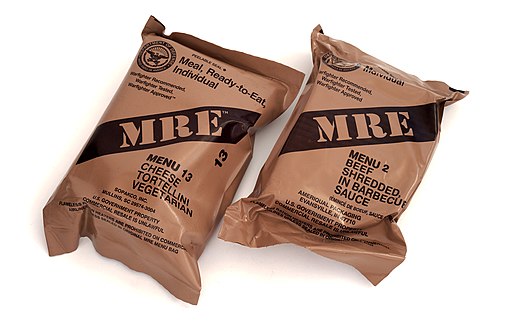Popular amongst preppers and survivalists, MREs are, in many ways, the ultimate survival food. Calorie-dense and nutritionally balanced, MREs are the main operational food ration for the United States Armed Forces.
MREs are undeniably useful, but are they healthy?
MREs are nutritious enough and designed to deliver as much nutrition and as many calories as possible. They do not, however, constitute a healthy diet, especially not if consumed for more than 21 days consecutively.
The Benefits Of Eating MREs

While MREs are probably the furthest you can get from gourmet cuisine, they’re surprisingly popular amongst civilians.
Author, Anastacia Marx de Salcedo, believes that MREs have helped people
“deal with a chaotic and unpredictable world,” giving them some much-needed “comfort food for courage.”
Furthermore, according to Dr. J. Philip Karl, a research dietitian at the US Army Research Institute of Environmental Medicine,
“The MRE actually provides more fiber and more of several vitamins and minerals compared to people’s typical diets.”
There’s no disputing the nutritional value of MREs. Containing approximately 1,200 calories, they give you enough protein, fat, and carbohydrates to perform the most taxing of tasks. Each MRE also contains one-third of the Military Recommended Daily Allowance of vitamins and minerals.
These benefits only go so far, however, as the reporter Juan Leon discovered when he took on the Independent Journal Review’s 21-day MRE challenge in 2016.
The Negative Effects Of Living on A Diet of MREs
Despite his initial confidence and enthusiasm, after 10 days of eating nothing but MREs, Juan started to experience stomach pains and constipation. By day 13, he said,
“Generally, I’m just feeling very, very tired and low energy. Physically, I just feel bloated all the time.”
Juan’s experiences were similar to those described by military personnel, many of whom have complained of gastrointestinal issues when living off MREs in operational environments.
Concerned that MREs were harming soldiers’ gut microbiota composition, the US Army Research Institute of Environmental Medicine launched a study aimed at establishing if there was a link between eating MREs and “a dwindling frequency of bowel movements.”
The study, involving 60 adults aged between 18 and 61 years old, found that MREs do, indeed, cause an “intestinal traffic jam,” largely because they lack the good bacteria found in fresh foods, like yogurt and fruit.
Despite that, the researchers concluded that MREs did not “increase IP [intestinal permeability] or inflammation,” nor did they “result in clinically meaningful gastrointestinal symptoms when compared to typical American diets.”
The trouble is, a typical American diet isn’t particularly healthy either. It contains too much fat, sodium, and sugar – just like your average MRE.
Why MREs Aren’t The Best Survival Food
As MREs were created for soldiers, they’re designed to fuel heavy physical activity. As a result, they contain high levels of fat and sodium, which is ideal if you’re running long distances, shooting at enemies, and digging ditches.
There Is Too Much Fat And Sodium In The Average MRE
If you’re sitting in a bivy sack waiting for the rain to stop, however, your body doesn’t need that kind of fuel.
Instead of expelling the excess sodium through sweat, you put yourself in danger of developing high blood pressure. Rather than burning off the high-fat content in an MRE, you’ll simply be sitting around as your cholesterol levels soar.
Even compared to the average American diet, the percentage of fat in a standard MRE is high. According to the National Center for Health Statistics, the diets of American men contain around 34.6% fat. For women, it’s slightly higher at 35.1%. In an MRE, however, you’ll be getting a whopping 36% fat. Only the most enthusiastic of survivalists are busy enough to benefit from that!
On the plus side, you can get some heavy physical activity simply from carrying a three-day supply of MREs. The average MRE weighs between 18 and 26 ounces, and you need three of them a day. That means adding nearly 200 ounces, or 12.5 lb, to your bug-out bag in food alone.
MREs Contain Very Little Dietary Fibre
MREs are also very low in dietary fiber, which is why they sometimes cause constipation. You will get some gum, sweetened with xylitol, that should alleviate some of your problems, and the crackers also contain a higher than average vegetable content, which is designed to improve digestion, but it’s doubtful these will be sufficient to ease your discomfort.
The lack of fiber means you’ll rarely feel full after an MRE and may experience fluctuations in your blood sugar levels and irregular bowel movements to boot. If you don’t believe me, watch this.
MREs Lack Flavor And Texture
While there’s no disputing the fact that MREs last a long time, just how long you’ll last eating nothing but Meal Ready to Eat is somewhat more questionable. To make matters worse, some MREs are virtually inedible.
In 2008, some unfortunate soldiers were given a Veggie Omelet in their MREs, which quickly became known as the Vomlet. With its gelatinous texture and complete lack of flavor, the Vomlet is universally agreed to be the worst MRE in military history.
You can get around some of the health issues associated with MREs by reading this article about where to buy cheap MREs online. Some of these offerings, like the reduced-sodium MREs from Sopakco, won’t put as much pressure on your digestive system, but even these can’t really be called healthy.
Conclusion
MREs are healthy enough to live on for a few days, but after that, your body will begin to take the strain.
If you’re determined to take MREs with you when you bug out, you might find that making your own MREs provides a healthier and cheaper alternative to pre-packaged meals.
That way, you can include items that contain healthy bacteria, like yogurt, and those that will help regulate your bowel movements, like refried beans.


